The MSI MEG X570 Godlike Motherboard Review: Thor's Flagship
by Gavin Bonshor on August 28, 2019 12:00 PM EST- Posted in
- Motherboards
- AMD
- MSI
- 10G Ethernet
- Ryzen
- PCIe 4.0
- Ryzen 3000
- X570
- X570 Godlike
- MEG
Visual Inspection
The MSI MEG X570 Godlike is an E-ATX motherboard which combines a wide variety of highly premium controllers and wraps it up in a very elegant design. On the aesthetics, MSI has gone with an all-black PCB which is flanked by a black metal and plastic rear panel cover, as well as the X570 chipset heatsink which is actively cooled, but uses the Zero Frozr technology; this means that the fan has a semi-passive design which ramps up when it needs to keep the warm running X570 chipset cool.
Along the bottom of the board is an overclocker's toolkit which consists of a reset button, power button, and an MSI Game Boost dial which allows users to select from seven different overclocking presets. Also located along the bottom are two little buttons which allow users to increase or decrease the base clock on the fly in steps of a single MHz; this is more for extreme overclockers looking to squeeze every last MHz of performance out of memory and CPU. Other headers around the edge of the board include two USB 3.1 G2 headers (four ports), one front panel USB 3.1 G2 Type-C port, two USB 2.0 headers (four ports), and a front panel audio header. The MSI MEG X570 Godlike has a total of nine 4-pin fan headers which are split into three main areas; one for the CPU fan, one for a water pump, and seven for chassis fans. There are also two 2-pin thermal sensor connectors and a 3-pin water flow connector meaning this model is very suitable for enthusiasts looking for a top of the range model to use with a custom water cooling loop.
Dominating the lower portion of the MSI MEG X570 Godlike's PCB is four full-length PCIe 4.0 slots which operate at x16, x8/x0/x8, x8/x4/x4, and x8/x4, with the bottom full-length slot running at PCIe 4.0 x4. Sandwiched in between the full-length slots are three PCIe 4.0 x4 M.2 slots each with its own individual Lightning Gen4 M.2 heat shield. MSI also includes six SATA ports, and due to MSI bundling the X570 Godlike with an M.2 Xpander-Z Gen4 add-on card using its Frozr cooler, we also get an additional two PCIe 4.0 x4 M.2 drives.
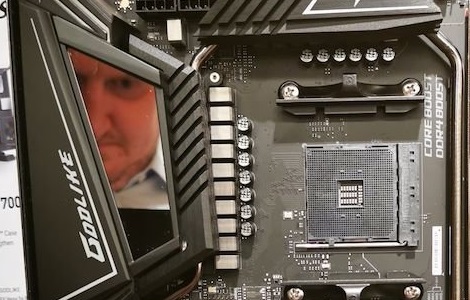
Me looking all angry and Godlike at Computex 2019 (Image credit to Coreteks)
On the rear panel cover is MSI's Infinity Mirror II panel which allows users to create funky RGB LED effects, something MSI has used before on previous models such as the MSI MEG Z390 Ace. This along with the 4-pin ARGB header, two 3-pin RAINBOW RGB headers and single 3-pin Corsair RGB LED header can be customized within the Mystic Light section of the MSI Dragon Center software.
Over on the right-hand side is four memory slots which support up to DDR4-4800 and up to 128 GB which is impressive in itself is the Dynamic Dashboard which allows users to view the board's vital statistics including various states of system status, and more impressively, allows users to upload their own animated GIF. This is made from OLED and its controls can be accessed from the MSI Dragon Center within the Mystic Light RGB utility.
Designed to push the 16 core CPU even higher, power deliveries for X570 have had to be upgraded over the previous X370 and X470 chipsets. The MSI MEG X570 Godlike is a primary example of this and runs a 14-phase power delivery for the VCore, and a 4-phase setup for the VGT/SoC. The PWM controller of choice is the International Rectifier IR35201 which is operating in 7+1 mode, with 14 x TDA21472 70 A power stages running with 7 x IR3599 doublers. On the SoC, it's slightly different with 4 x TDA21472 70 A power stages, but with a single IR3599 doubler which looks to be splitting the PWM signal into four. Providing power to the CPU is two 8-pin 12 V ATX CPU power inputs.
The VGT/SoC could have easily have been designed with just two phases, but there's an element of marketing strategy with vendors that more means better, which isn't always the case. Cooling the power delivery is a large and robust aluminium heatsink which is interconnected via a heat pipe to the actively cooled X570 chipset heatsink.
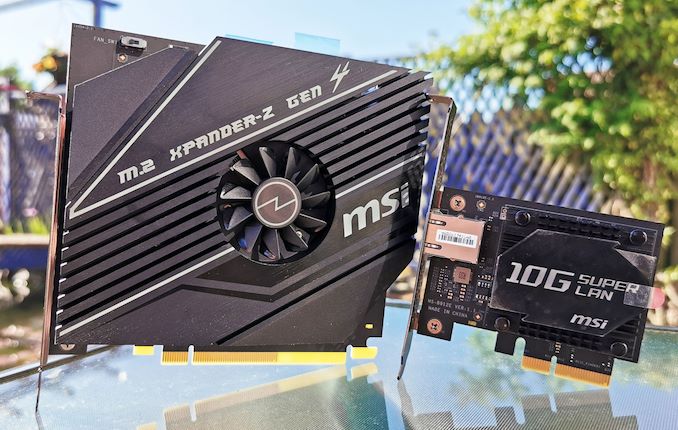
M.2 Xpander-Z Gen4 with two M.2 slots (left), Aquantia AQC107 10 G LAN Addon Card (right)
Another interesting inclusion is a dedicated 10 G Aquantia AQC107 NIC add-on card which gives users the choice to use either 10 G or use the integrated Killer E3000 2.5G and Killer E2600 Gigabit Ethernet ports located on the rear panel. Also featured is the Killer AX1650 Wi-Fi 6 802.11ax wireless interface which also includes support for BT 5.0 devices. This enables other features, such as offering the system using the Wi-Fi interface as an access point.
As it currently stands, the MSI MEG X570 Godlike is the only model to feature two Realtek ALC1220 HD audio codecs. One powers the rear panel audio connectors, while the second is for the front panel audio connector. Supplementing these is twelve gold Japanese audio capacitors, as well as four WIMA audio capacitors around the ESS E9018 Sabre DAC which drives the 6.3mm stereo headphone output on the rear panel. MSI has also included a physical layer of audio PCB separation to reduce electrical interference.
Looking closer at the rear panel of the X570 Godlike, there are three USB 3.1 Gen2 Type-A, one USB 3.1 G2 Type-C, and two USB 3.1 G1 Type-A ports. Commonly featured on premium models, the MSI MEG X570 Godlike also has a pre-installed rear panel IO shield. Also present is a Flash BIOS button with a highlighted Type-A port dedicated to firmware flashing, as well as a Clear CMOS button, and a PS/2 combo port. The onboard audio is high-end as in addition to the Realtek ALC1220 HD audio codecs which drive the five 3.5 mm jacks and S/PDIF optical output, MSI has included an ESS E9018 DAC for good measure, which also powers the dedicated 6.3 mm jack for studio headphones for audiophiles. The rear panel has two Ethernet ports with a Killer pairing consisting of an E3000 2.5 G, and E2600 Gigabit NIC, with a Killer AX1650 powering this model's Wi-Fi 6 802.11ax wireless capabilities.
What's in the Box
One of the aspects that makes the MSI MEG X570 Godlike such a premium product is the accessories bundle accompanying it. We've already touched on the M.2 Xpander-Z Gen4 add-on card which allows users to add an extra two M.2 drives to the three PCIe 4.0 M.2 slots onboard, and the additional Aquantia AQC107 10G Super LAN NIC, but there's more. Also included inside the box are six red and black braided SATA cables, a number of RGB extension cables, an antenna set for the integrated Killer AX1650 Wi-Fi 6 wireless interface, a 6.3 mm audio adapter, a user manual, with an additional quick installation guide also included for good measure.
- 6 x Red and black braided SATA cables
- RGB LED Y 80 cm extension cable
- Corsair RGB LED 50 cm extension cable
- Rainbow RGB LED 80 cm extension cable
- Corsair to Rainbow RGB 10 cm extension cable
- 2 x Thermistor cables
- Killer AX1650 antenna set
- M.2 Xpander-Z Gen4 M.2 add-on card
- 10 G Super LAN add-on card
- 3 x M.2 installation screws
- 6.3 mm audio adapter
- Case badge
- SATA cable label sheet
- Product registration card
- Driver installation disk
- User manual
- Quick Guide
- Quick installation guide


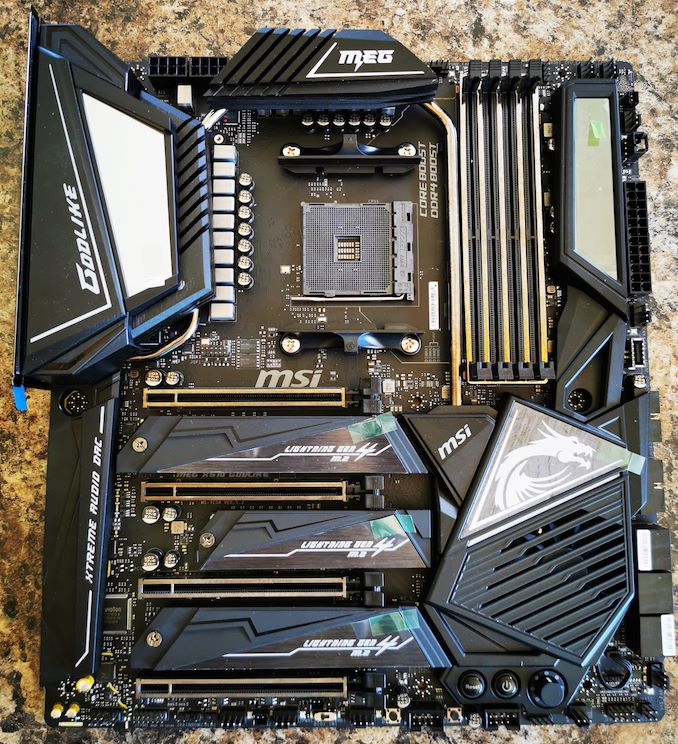
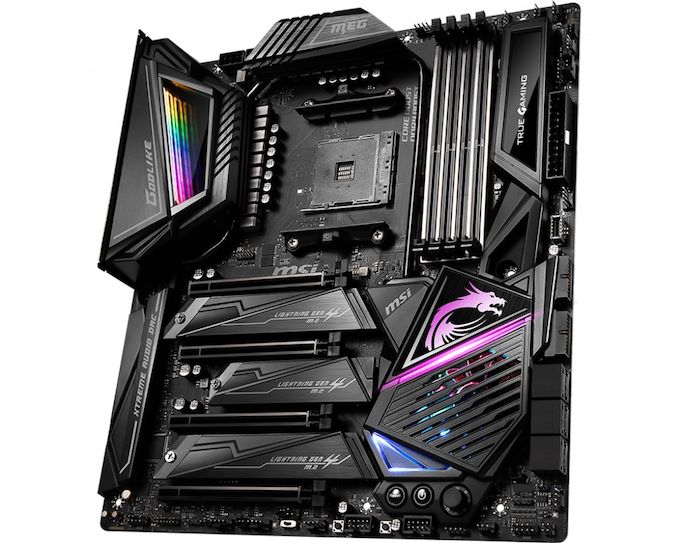
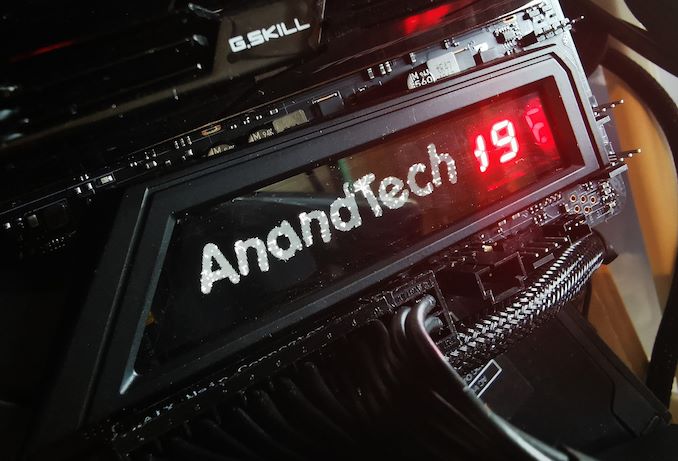

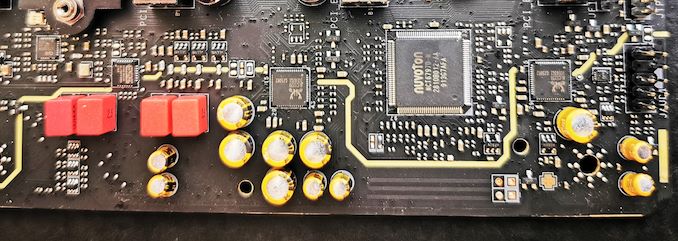

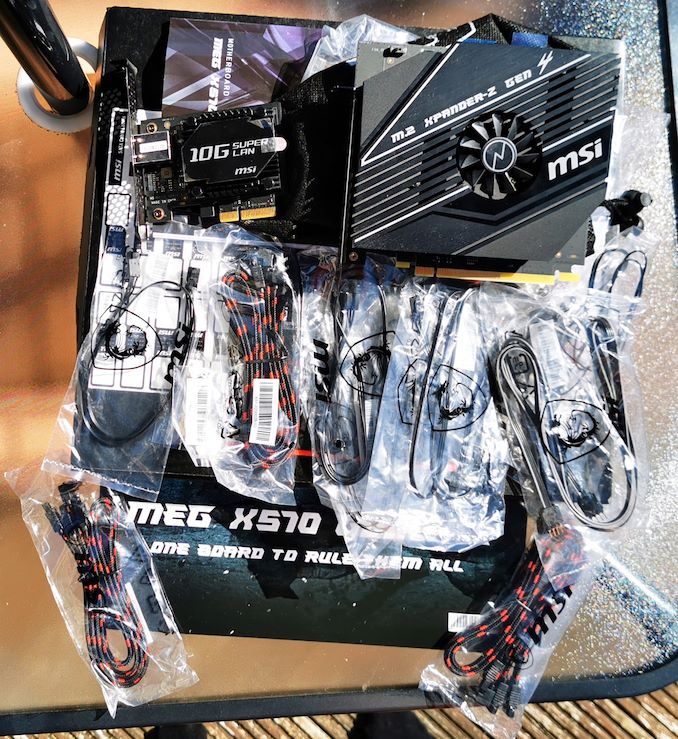








116 Comments
View All Comments
WaltC - Thursday, August 29, 2019 - link
Not to mention an old architecture Intel's been milking for years that is full of security holes and software & bios patches, etc. Nah, the longevity argument and bang-for-the-buck argument is won by AMD this time, decisively.Oliseo - Thursday, August 29, 2019 - link
"Not to mention an old architecture Intel's been milking for years that is full of security holes and software & bios patches, etc. Nah, the longevity argument and bang-for-the-buck argument is won by AMD this time, decisively."Be careful of comments like this. They may come back to haunt you. Just because there seems to be no security issues in AMD does not mean they don't exist.
After all, it's not like you were screaming about spectre a couple of years ago, was you.
Oxford Guy - Thursday, August 29, 2019 - link
Reality is that people buy what's available today. Today, there are more security problems with Intel than with AMD.Today, Intel has a worse track record for security robustness.
However, I will say that both companies embed black boxes into their chips. AMD stripped PSP for China, presumably to add a different black box.
29a - Friday, August 30, 2019 - link
Is the next Ryzen using the same socket?Qasar - Friday, August 30, 2019 - link
given AMD's track record for upgrade ability, its quite possible, it could.Threska - Saturday, August 31, 2019 - link
Future Proofing? So that means we've finally gotten something definite about 2020 forward on socket AM4, and PCI 5.Peter2k - Thursday, August 29, 2019 - link
Or buy a solid X570 for way less and still get an all core of 4.2The difference you achieve with pricier boards is negliable really, AMD or Intel
Also I have no idea why you're bashing and then referring to Intel in this regard, you can easily buy a 700$, or even 1000$ Z390
Sweetbabyjays - Thursday, August 29, 2019 - link
"get an all core of 4.2" according to silicon lottery's statistics, only the top 21% of their 3700x cpu's tested could get to 4.15GHz (all core). So to get a guaranteed 4.2 you need to get a 3800x.I agree that the difference with pricier boards is negligible, really your silicon is more determinate of your max OC than your motherboard.
The reason I'm bashing (this $700 motherboard specifically) is because if you're willing to dump $700 on a motherboard in the pursuit of performance you can literally pay that $700 for a cpu and motherboard combo(the 9900k and a Z390 board) that destroys the performance of the 3700x (the one tested in the article) and any motherboard.
If you compare product level to product level you will find that the X570 price vs Z390 version of say the Gigabyte AORUS XTREME or the MSI MEG Godlike, is ~ $150 and $100 respectively more expensive for the X570 version.
If you need an 8c/16t cpu and you're after the highest performance overclocked option, why pay more for a 3700x/X570 for less performance than a 9900k/Z390?
AshlayW - Thursday, August 29, 2019 - link
Dude where are you getting that 3700X/X570 costs more than 9900K/Z390? The CPU alone is like 150 bucks cheaper, and decent X570s are around 150-200 bucks, the same as decent Z390s. You also have to buy the cooler for the Blast Furnace 9900K to get it anywhere near those "4.8GHz" clocks you're going to need another 50 bucks on a cooler, whereas the 3700X can use its included Prism easily. By your own admission "5-10%" performance isn't worth it, so why pay 150-200 bucks more for a less efficient, dead-end, security vulnerability ridden product based on tech from 2015, when you can have 90% its performance with the latest features including PCIE4.0, for less money?I'm sorry mate but you're not making sense or you're delusional. Please don't spread misinformation, and I suggest people go to their favourite retailer/store and check prices if they want to confirm it themselves.
Sweetbabyjays - Thursday, August 29, 2019 - link
Ashlay you need to cool your jets broseph.The first section of my comment is referring to how pointless this $700 board is when you can spend that $700 and get a Z390 and 9900k that will beat the cpu tested in the article (3700x) on this monstrosity of a board.
Then I commented how X570 in general has an inflated cost that really hurts the value proposition of the Ryzen CPUs when you compare model tier to model tier.
As per PC Partpicker:(my source wasn't mentioned, so sorry for not saying that)
MSI X570 Godlike $689.99
MSI Z390 Godlike $578.86
Difference: ~$111
Gigabyte X570 AORUS XTREME $706.98
Gigabyte Z390 AORUS XTREME $549.99
Difference: ~$150
To get the 9900k to 4.8 is really very little effort at all and most can go there with 1.25V which again is pretty tame and hardly creates the "furnace" you're talking about. Yes at 5.1 GHz and say 1.4V the 9900k is probably excellent for tempering swords and casting iron. The 3700x can use it's stock cooler easily, at stock speeds, I totally agree, but once you get that overclock going, you are going to need a better cooler, note the temps above are with 240mm AIO on the 3700x.
I'm not going to argue with the efficiency, because AMD did quite well in that regard with their 7nm process, it clearly is more power efficient.
As far as security issues they have both had their own issues over the years, although Intel has had a fair amount more.
I think though you really hammer the point i am making home with your statement "...product based on tech from 2015, when you can have 90% its performance..."
Intel tech from 2015 is still 10% better performing than AMD's best and newest tech in 2019.
Then you say in another comment "they've won the performance and value games both at once." i never knew 10% less performance is better.
As for PCIE 4.0 if AMD has big Navi coming that can actually outperform a PCIE 3.0 x16 slot's bandwidth then I will be the first in line to get a 3900x and x570. But until there is a single card that is limited by PCIE x16 I personally don't see any reason for it. Sure ridiculously fast nvme drives are nice, but again, they don't do a whole lot to improve gaming or most workflows.